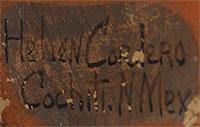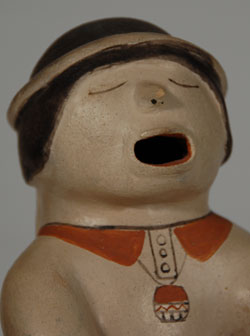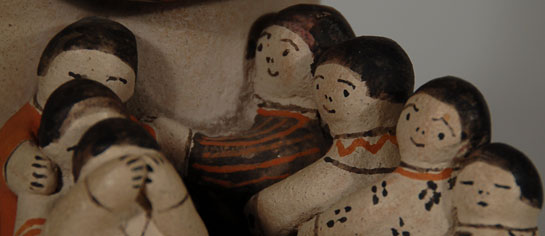Helen Cordero Cochiti Male Storyteller with 7 Children [R]
+ Add to my watchlist Forward to Friend
Forward to Friend
- Category: Figurines
- Origin: Cochiti Pueblo, KO-TYIT
- Medium: clay, pigment
- Size: 10” tall x 4-1/2” wide x 7-3/4” deep
- Item # C3291
- Price No Longer Available

What is known today as a Storyteller figurine had its beginning in 1964 from the hands of Cochiti Pueblo potter Helen Cordero. Alexander Girard, the noted architect and folk art collector, saw a figurine by Cordero at a Santo Domingo feast day arts and crafts booth and requested that she make more and larger ones and bring them to him. He continued to encourage her to make larger ones with more children. When Cordero began thinking about his requests, she made a male storyteller with several children based on her remembering that her grandfather was a storyteller at the pueblo. Her creation, based on her grandfather, was the beginning of the storyteller figurine tradition at Cochiti Pueblo. In the almost five decades since her creation, the storyteller figurine tradition has blossomed.
Today, many potters at almost all the pueblos make figurines, some male and some female, but Cordero continued only making male storytellers because of the connection to her grandfather. She never made a female storyteller. Her female figurines are called other names, such as Singing Mother, Hopi Maiden or other names. Cordero used to say that the other potters who made female storyteller figurines didn't understand her intent.

This figurine is a testament to Cordero's talent. It is beautifully sculpted and painted. One of the children has his hands over his eyes as if the story being told is scary. The other children are all hanging on to each other as if afraid of falling off the adult's leg.
The adult is wearing his hair tied in a chongo in the back, has a head band around his forehead and is wearing a shell necklace around his neck that was very popular in the 19th century. He has elaborate embroidery around the edge of his shirt and is wearing traditional brown moccasins. The children seem to all be dressed as boys.
The figurine has a marvelous patina that fits with its age. It dates to the early 1970s, a period accepted as Cordero's best. It is signed Helen Cordero Cochiti, N Mex. It is in excellent condition. This is one of the finest looking and one of the largest Cordero storyteller figurines of this period that we have had. It is truly a marvelous piece.
Provenance: from the estate of Richard L. Spivey, author of several books on Maria Martinez and family.
Recommended Reading: The Pueblo Storyteller: Development of a Figurative Ceramic Tradition by Barbara Babcock

- Category: Figurines
- Origin: Cochiti Pueblo, KO-TYIT
- Medium: clay, pigment
- Size: 10” tall x 4-1/2” wide x 7-3/4” deep
- Item # C3291
- Price No Longer Available



